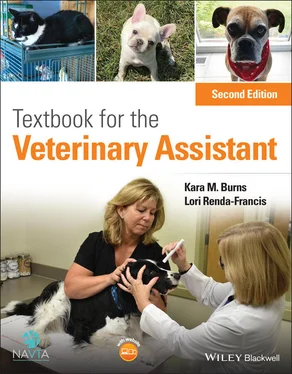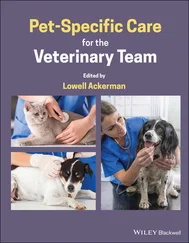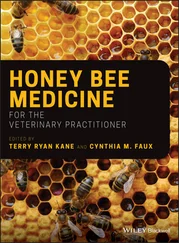Laws set the boundaries to which individuals must adhere. They are a system of rules created and enforced through legislation to regulate behavior
Ethics is usually centered around principles even higher than legal requirements. Additionally, members of professions, especially medical professions, are expected to adhere to ethical standards above those considered appropriate for individuals not involved in a medical profession. Pet owners accept, without question, the decisions and judgments made by medical professionals because of their education and expertise.
The AVMA provides principles of veterinary medical ethics for licensed veterinarians and can be found at www.avma.org/resources‐tools/avma‐policies/principles‐veterinary‐medical‐ethics‐avma
Veterinary medicine has a code of ethics for health‐care team members to follow. Both veterinarians and veterinary technicians have a code of ethics. Additionally, when entering the veterinary profession, after meeting all the requirements for becoming a licensed veterinary medical professional, veterinarians and veterinary technicians take an oath to use their skills and knowledge for the benefit of animal health, animal welfare, public health, and the advancement of medical knowledge. All members of the veterinary health‐care team adhere to the medical profession’s ethic of Primum non nocere – first do no harm.
The veterinary technician oath is as follows: “I solemnly dedicate myself to aiding animals and society by providing excellent care and services for animals, by alleviating animal suffering, and promoting public health.
I accept my obligations to practice my profession conscientiously and with sensitivity, adhering to the profession's Code of Ethics, and furthering my knowledge and competence through a commitment to lifelong learning.”
The veterinary technician code of ethics and oath can be found on the NAVTA website: www.navta.net/page/TechnicianOath
Coinciding with the evolution of electronic communication are systemic changes in health‐care delivery. An increasing amount of medical knowledge is necessary to deliver even the most basic care. Telemedicine, the use of technology in the delivery of medicine to advance clinical care at a distance, is increasing in use. However, since the SARS‐CoV‐2 pandemic, telemedicine has become more significantly utilized to provide care to pets while keeping the safety of owners and veterinary team members at the forefront. As has been seen to date, telemedicine has helped to continue medical care and has the potential to transform patient‐centered care. Technology platforms allow veterinary team members to communicate with pet owners through a variety of means, including text, email, and mobile device applications. This technology is especially important when more members of the veterinary team are involved, as it can enable communications between members of the team, thus improving overall coordination of care.
However, in medicine as a whole – human and veterinary – there are concerns about the adoption of telemedicine and its potential impact on patient care. Ensuring that telemedicine is ethically acceptable will require anticipating and addressing possible drawbacks such as the impact on the veterinarian–client–patient relationship (VCPR), imposing one‐size‐fits‐all applications, and the belief that new technology must be effective.
The veterinary team must consider the same ethical issues with telemedicine that have always been thought of when providing care for patients. Focusing on maintaining a strong VCPR, advocating equity in access and treatment, and seeking the best possible outcomes, telemedicine can enhance veterinary practice and patient care in ways that provide quality medicine and are ethical.
The veterinary health‐care team comprises many positions, each with various roles and responsibilities. It is important that teamwork is emphasized, as good patient care is a result of great teamwork.
1 McCurnin, D.M. and Bassert, J.M. 2017. McCurnin’s Clinical Textbook for Veterinary Technicians, 9th edition. W.B. Saunders Company, St Louis, MO.
2 Prendergast, H. 2011. Front Office Management for the Veterinary Team. Saunders Elsevier, St Louis, MO.
3 Sirois, M. 2017. Principles and Practice of Veterinary Technology, 4th edition. Mosby, St Louis, MO.

www.wiley.com/go/burns/textbookvetassistant2
Please go to the companion website for assignments and a PowerPoint relating to the material in this chapter.
Chapter 2 Medical Terminology
Medical terms are made up of many different elements. It is important for veterinary assistants to have a clear understanding of the various parts of a word. Understanding each part will aid in learning the meaning and spelling of that word. You will be expected to recognize, pronounce, spell, and utilize commonly used medical terms. It is helpful to note that there are four main parts to a word.
Prefix
Suffix
Root
Combining form of a root word
A prefixis placed at the beginning of a word and consists of one or more syllables. It will modify or alter a verb, adjective, or noun, thereby creating a new word. The prefix usually indicates number, time, location, or status.
A suffixis the ending of a word and consists of one or more syllables. Similar to the prefix, a suffix is added to a root word to modify or alter its meaning. The suffix usually indicates procedure, disease, disorder, or condition.
The rootis the central part of the word and is the foundation or essential meaning of a word. It may be a complete word in itself or a part of a word.
A combining formof the root word is a root with a combining vowel. The purpose of combining forms of root words is to make the resulting word easier to pronounce. Examples of the combining form of a root word are shown in the following list. The word root is in italic letters, and the combining vowel is in parentheses.
orth(o)pedic
bacteri(o)static
quadr(i)plegic
When we take a root word such as “derm‐,” which means “skin,” and combine it with the suffix “‐itis,” it becomes “dermatitis.” Dermatitis is an inflammation of the skin. If we take the same root word and include the prefix “pyo‐,” we create the word “pyoderma,” which is defined as bacterial infection of the skin.
Words are made up of one or more of these parts. Medical terms deal with the diagnosis and treatment of disease and the maintenance of health. It is important for veterinary assistants to understand the meaning of the word parts in order to be able to dissect medical terms in a logical way.
Correct spelling of medical terms is essential because a misspelled word may give an entirely different meaning! Changing just one or two letters can change the entire meaning of a word. For example, a macrocyte is an abnormally large red blood cell, but a microcyte is an abnormally small red blood cell. Two or more medical terms may also be pronounced in the same way but have different meanings. For example, ileum and ilium are pronounced in the same way. However, ileum is the distal part of the small intestine while ilium is part of the pelvis.
Tips for succeeding in learning medical terminology
Since students learn in various ways, it is important to utilize a variety of methods to learn medical terminology. For some students, writing words helps them to learn faster than simply reading them. Some students retain material better when they use various learning methods. Speaking into a tape recorder and using it to practice pronunciation is helpful. Proper pronunciation of medical terms takes time and practice. Listening to how words are pronounced by medical professionals and using medical dictionaries and textbooks are the best ways to learn pronunciation. Making flash cards to quiz yourself may be another useful method. There are also online quizzes and flash cards available. The key is repetition. Learning and memorizing these terms will require time and concentration.
Читать дальше













